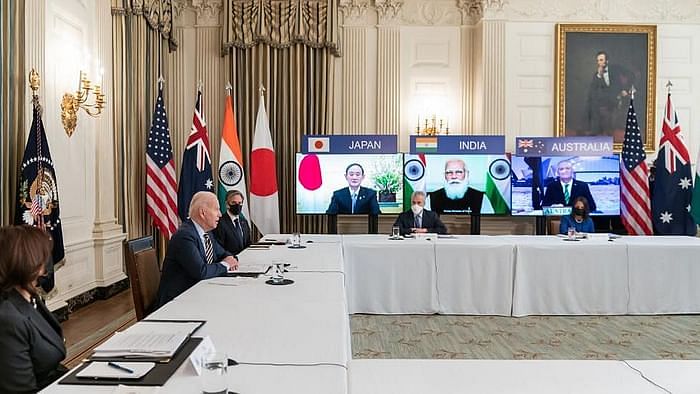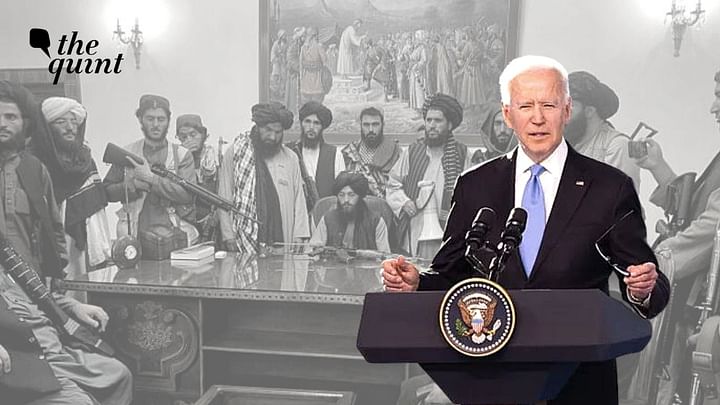“I was not going to extend this forever war, and I was not extending a forever exit … The fundamental obligation of a president, in my opinion, is to defend and protect America, not against threats of 2001, but against the threats of 2021 and tomorrow. That is the guiding principle behind my decisions about Afghanistan,” said US President Joe Biden in his address to Americans a day after the last US troops left Kabul.
There are many words to describe what the Americans and the NATO have done in Afghanistan. You could use the neutral term “withdrawal”, but any objective person would describe what happened to them as a combination of a retreat and a rout.
True, the withdrawal was in reasonably good order, and but for 13 soldiers killed in last Thursday’s bomb attack, the US did not suffer casualties. But how do you judge an army that left behind a vast quantity of weapons and equipment on the battlefield and abandoned thousands of supporters whose lives and liberties could be at risk at the hands of the Taliban?
The Shock Departure From Bagram
True, a large number of the weapons are those supplied to the Afghan National Security Forces (ANSF) that collapsed in the face of the Taliban. Between 2002-2017, the US gave the ANSF $28 billion worth of weaponry, including guns, rockets, night-vision goggles, some 2,000 armoured vehicles, 40 aircraft, including UH-60 Black Hawks, Scout attack helicopters and ScanEagle drones. Now, all of it is with the Taliban.
But the real measure of American incompetence came through its decision to abandon its major and well-protected base in Bagram, an hour’s drive from Kabul, without informing the Afghans. Remarkably, this hubristic act took place on 2 July, two days before the 245th year of American independence.
This shock departure, complete with the lights being turned off at the time of departure, was the final knock-out punch delivered to the ANSF’s gut. At one stroke, it wiped out a key battle-winning attribute of a military force — morale. Till this time, not a single of Afghanistan’s 34 provincial capitals had fallen to the Taliban.
The cruel irony is that two weeks later, 6,000 American troops had to be sent back, this time to the less secure Kabul airport, to carry out the evacuation of civilians.
Is the Afghan Army Really To Blame?
It is easy now to blame the ANSF for incompetence and even cowardice, but a closer analysis would reveal that the larger US plan for leaving the country, which had been in place for a decade, was deeply flawed. Instead of leaving behind a fully functioning army, the ANSF was crucially dependent on US air, intelligence support and maintenance support. When that was abruptly cut off, they lost heart. Sensitive to Pakistani concerns, the US had not allowed the ANSF to develop all the capabilities needed by a modern army.
In contrast, in 1989, the Soviet Union had conducted a fighting retreat and put in place a government under Najibullah, which successfully took on the Mujahideen till the Soviet Union collapsed and the Afghan state ran out of money and support and was overwhelmed by the US-Pakistan-Saudi supported jihadis.
There are other issues as well about the American “withdrawal” that should concern us. For example, the US did not involve the elected government of Afghanistan in the process at all. The Ashraf Ghani government was elected by a minority of people in an election that was controversial. Yet, for advocates of democracy like Biden, it had sufficient legitimacy so that its exclusion from the peace process was tantamount to a travesty.
Indeed, by excluding the Ghani government from the peace process, the US effectively delegitimised it. It was left to Russia to host talks involving the Taliban and the Afghan government’s High Peace Council.
Close regional friends like India, too, were excluded from the process whose aim seemed to be to get the Americans and the NATO out of Afghanistan, regardless of consequences. Incidentally, and South Block needs to note this, as per the Doha deal, the Taliban commitment to not allowing its soil to be used to threaten the security of others is limited to “the United States and its allies”.
After the deal was signed, the US and NATO contingent got busy with dismantling their bases. Freed from worries about them, the Taliban intensified their attacks against the ANSF, contrary to the letter and spirit of the Doha accords.
A String of Foolish Decisions
There is another question mark here, this one relating to NATO, since this was seen as the first mission in the outfit’s history where the collective defence provision under Article V was invoked. The Americans may have done the heaviest lifting in the Afghan war, but its NATO allies — Germany, France, Britain, Canada, Turkey, Norway, Belgium, Sweden and other members — also had troops fighting on the ground till 2014. Thereafter, it became an advisory mission. But the US eventually signed a bilateral deal with the Taliban in February 2020. It may have kept its allies in the loop, but the eventual denouement in Kabul is not something that will have heartened the Europeans.
A former US ambassador to Afghanistan, Ryan Crocker, has written about the lack of strategic patience on the part of the US in dealing with the situation that presented itself in the country. The problem is that in relation to the withdrawal or retreat, even tactical patience was missing.
As another writer pointed out, it was foolish to withdraw at the height of summer when the Taliban are out in full strength, where they could have been confined to their sanctuaries had it been winter.
But more germane is the issue of announcing your departure by a particular date. This gives the adversary a huge advantage in that they can decide the pace and momentum of their campaign.
Instead, the Americans should have used the metric of conditions on the ground. They could have asked for a ceasefire pending final withdrawal or the completion of negotiations between the Afghan government and the Taliban, and pending that, maintained the token force of 2,500 personnel they had at the beginning of this year when the government controlled all the urban centres.
Indeed, the first provincial capital to fall, Zaranj, was as late as August 6. Located near the Iran border, this is the start point of the Indian-built road leading to Delaram, aimed at linking Afghanistan to the outside world through Chah Bahar.
No, the US Won't Turn Its Focus to China
There is some facile analysis that argues that having given up its long-running liabilities in the Middle East, the US will rebound with greater vigour in confronting China in the Indo-Pacific. This analysis fails to understand the current isolationist current in the United States, which would hardly back a military venture against a major power like China after having suffered a catastrophe in Afghanistan and Iraq. Also, how much trust would friends and allies retain in the US, given the way it handled its Afghan departure?
Given the American record in Afghanistan, it would require a brave person to accept that what happened in Kabul was an aberration and Washington will now neatly and strongly pivot to the Indo-Pacific.
Leave alone allies, the impact of the Biden administration’s handling of the situation has left deep scars on the US itself, especially its armed forces. This is evident from critical statements like that of serving Marine colonel Stuart Scheller and the retired military fraternity. There was a time when the stoic acceptance of casualties marked the American warrior ethos. Today, that seems to have been shredded, with the relatives who lost their near and dear excoriating Biden for his handling of the situation.





